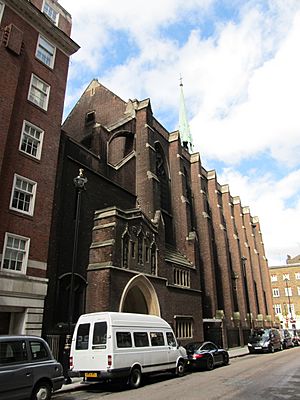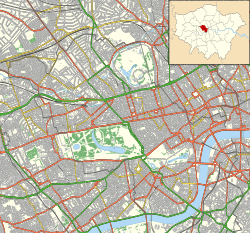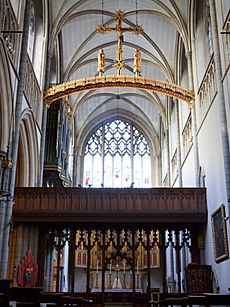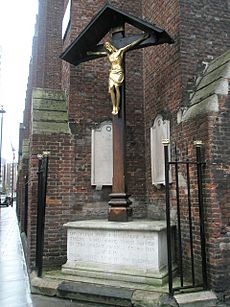Church of the Annunciation, Marble Arch facts for kids
Quick facts for kids Church of the Annunciation, Marble Arch |
|
|---|---|

Church of the Annunciation, Marble Arch
|
|
| 51°30′52″N 0°9′31″W / 51.51444°N 0.15861°W | |
| OS grid reference | TQ278810 |
| Location | Bryanston Street, Marble Arch, London, W1H 7AH |
| Country | England |
| Denomination | Church of England |
| Churchmanship | Anglo-Catholic |
| Architecture | |
| Heritage designation | Grade II* listed |
| Architect(s) | Sir Walter Tapper |
| Style | Gothic Revival |
| Years built | 1911 |
| Administration | |
| Parish | St Marylebone Annunciation Bryanston Street |
| Deanery | Westminster Marylebone |
| Archdeaconry | Charing Cross |
| Diocese | London |
The Church of the Annunciation, Marble Arch, is a beautiful Church of England parish church located in the Marble Arch area of London, England. It is dedicated to the Annunciation to the Blessed Virgin Mary, which is when the Angel Gabriel told Mary she would be the mother of Jesus.
This church is a Gothic Revival building. This means it was designed to look like the grand churches built in the Middle Ages. Sir Walter Tapper designed it, and it was built in 1912–1913. It is considered a very important building, listed as Grade II*.
The worship style at the Annunciation is Anglo-Catholic. This is a tradition within the Church of England that has many similarities to Roman Catholic practices. The church is also known for its amazing choral singing. It has strong ties to a local primary school, Hampden Gurney School.
Contents
History of the Church
The Church of the Annunciation is found near Bryanston Square and Montagu Square. This area is part of the Portman Estate, which was developed by Henry William Portman in the 1700s. The buildings here are in a neoclassical style, which means they look like ancient Greek and Roman buildings.
From Quebec Chapel to Annunciation Church
Before the current church, there was a chapel called the Quebec Chapel on the same spot. It was built in 1787 to remember the Battle of Quebec. People think it might have been built where the Portman Barracks used to have a riding school. By the early 1900s, the Quebec Chapel was old and falling apart. It was taken down in 1911 to make way for the new Church of the Annunciation.
One famous priest who worked at the Quebec Chapel was Henry Alford. He was a theologian and wrote many hymns, including the well-known "Come, ye thankful people, come".
A Church with Strong Beliefs
The Annunciation Church has always been closely connected to the Anglo-Catholic movement. This movement started in the mid-1800s and aimed to bring back older traditions to the Church of England.
In the early 1900s, many Anglo-Catholics were not in favor of the growing Ecumenical movement. This movement encouraged different Christian churches to work together. In May 1951, a big Christian gathering was held in Hyde Park to celebrate the Festival of Britain. Some Anglo-Catholic clergy and people, led by Rev. Hugh Ross Williamson, held a protest meeting at the Annunciation Church. They were concerned that leaders of the Church of England were sharing a platform with Methodists and Baptists. These groups, in their opinion, did not fully agree with the "traditional Faith of the Church."
They wrote a letter saying they worried that the Church of England's involvement might make it seem like only Roman Catholics defended the "full Catholic Faith." The famous poet John Betjeman signed this letter. Even though he told his friend T. S. Eliot that he found the protest a bit "extreme," he felt he had to support his fellow signers. The novelist Rose Macaulay also commented on the protest, expressing her surprise at the opposition to the rally.
Architecture and Design
The current church was designed by the English architect Sir Walter Tapper. It was built between 1912 and 1913. Tapper learned from George Frederick Bodley, who was a master at designing buildings that looked like they came from the Middle Ages.
The church is tall and made of red brick. It is designed in the Late Gothic Revival style, sometimes called Edwardian Gothic. It has stone decorations and buttresses, which are supports built into the walls. It also has a bell tower with a pointed roof. The single bell was made in 1913 by John Warner & Sons in Spitalfields.
The famous architectural historian Nikolaus Pevsner once described the church as "a fragment of a major medieval church." This means it looks like a small part of a much larger, grand medieval cathedral.
Inside the Church
The inside of the church features a rood screen. This is a decorative screen that separates the main part of the church (the nave) from the altar area (the chancel). Above this screen is a tall triumphal crucifix. This cross is thought to have been made by Robert Bridgeman of Lichfield, following Tapper's designs.
The high altar has a reredos, which is a decorated screen or wall behind the altar. This was also designed by Tapper and made by Jack Bewsey. Jack Bewsey also created most of the beautiful stained glass windows in the church.
Around the main part of the church (the nave), you can see plaster cast Stations of the Cross. These are a series of images showing Jesus's journey to his crucifixion. They were designed by Aloïs de Beule from Ghent.
There is also a special stone carving called a lapidarium that stretches over the arch between the sanctuary and the Lady Chapel. This was designed by Augustus Welby Northmore Pugin. It originally hung above the high altar of St Chad's Cathedral, Birmingham.
The church's organ was built in 1915 by Sir Frederick Rothwell. Its case, or outer shell, was also designed by Tapper. The organ was restored in 1989 by Bishop & Son organ builders.




